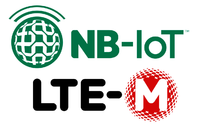This article provides application examples, such as, document references, tips related to STM32 Cellular.
1. What are Cellular LTE CatM and NBIoT?
LTE CatM and Narrowband Internet of Things (NBIoT) are low-power wide-area network (LPWAN) radio technology standards developed by 3GPP to enable a wide range of cellular devices and services.
NBIoT focuses specifically on indoor coverage, low cost, long battery life, and high-connection density.
The advantage of LTE CatM over NBIoT is its higher data rate, mobility, and voice over the network. However it requires more bandwidth and it is more costly.
Refer also to GSMA's NBIoT / LTE CatM world wide coverage information[1].
2. Wiki MCU / Cellular: pages breakdown
Below are the direct links to access dedicated articles. For beginners, it is recommended to start by reading the next chapter first.
- Cellular overview (this current article)
- Cellular hardware setup (Information about supported hardware setups)
- Cellular X-CUBE-CELLULAR (Information about the software part)
- Cellular How To (multiple "How to" to support users)
- Cellular F.A.Q (frequently asked questions)
3. Getting started with STM32 and Cellular LTE Cat M and NBIoT
From a hardware point of view, STMicroelectronics offers various ways to set up cellular connectivity solutions on STM32 MCUs.
For STM32 boards that support the STMod+ connector, STMod+ modem boards can be directly connected to the STM32 board.
For STM32 boards that do not have an STMod+ connector, an ARDUINO® / STMod+ adapter (X-NUCLEO-STMODA1) can be inserted between the STM32 board and the modem board.
To obtain a complete setup, packs are available that contain the STM32 board together with the modem board. Otherwise the STM32 board and the modem board can be ordered separately. For more information refer to the hardware setup article.
Note that for each version of the Cellular middleware software there is a set of supported hardware. Further details are available in the hardware setup article.
On the software side, X-CUBE-CELLULAR (X-CUBE Expansion Package) provides a software solution to allow customers to quickly and easily develop their own firmware:
- Based on ThreadX (fromV7.x onwards) and FreeRTOS (From V1.0.0 onwards)
- Users can choose to use either the IP stack in the modem or in the STM32 (LwIP or NetX Duo)
- Command line through Virtual COM UART over USB ST-LINK to configure the cellular connectivity parameters (technology selection, bands, APN, and others), and the connection to the cloud IoT platform
- Easy to support a new modem.
Several applications are provided as examples.
For more information see the X-CUBE-CELLULAR Wiki article.
New hardware setups and new software features in X-CUBE-CELLULAR are provided to customers over time.
4. How to...
This part is a guideline that describes how to perform the main activities with X-CUBE-CELLULAR. All the information is merged in the Cellular How To Wiki article.
5. FAQ
All the frequently-asked questions are listed in the dedicated Cellular F.A.Q Wiki article.
Zigbee 3.0 mesh to cloud over cat-M with BLE 5.0 user control (MWC/EW 2020)
ST at CES 2019 - LTE IoT Starter Kits
STM32 Cellular to Cloud Discovery Packs: 2G/3G and Espruino JS, LTE IoT! Embedded World 2018
Getting started with STMicroelectronics cellular IoT discovery kit
How to program FP-SNS-DATALOG1 firmware on STWIN using STM32CubeProgrammer
7. Specific tools
Those tools can be used in users projects but are not mandatory.
- STMicroelectronics’ STM32 Power Shield to power and analyze current consumption[2]
- Network simulator for both LTE CatM & NBIoT[3]
8. Terms and definition
| Term | Definition |
|---|---|
| API | Application programming interface / Access point identifier |
| APN | Access point name |
| BSD | Berkeley software distribution |
| BSP | Board support package |
| CID | Context ID (context identifier of a cellular connection) |
| CLI | Command-line interface |
| COM | Cellular communication |
| DC | Data Cache |
| HAL | Hardware abstraction layer |
| IDE | Integrated development environment |
| IF | Interface |
| IoT | Internet of things (refer to [4]) |
| IPC | Inter-processor channel |
| LED | Light-emitting diode |
| NAT | Network address translation |
| NFMC | Network-friendly management configuration (refer to [4]) |
| MNO | Mobile network operator |
| MVNO | Mobile virtual network operator |
| PDN | Packet data network |
| PDP | Packet data protocol |
| PPP | Point-to-point protocol |
| PPPoSIF | PPP over serial IF |
| PS | Packet switching |
| RAM | Random-access memory |
| RSSI | Received-signal strength indication |
| RTC | Real-time clock |
| TCP | Transmission control protocol |
| UDP | User datagram protocol |
| URC | Unsolicited result code |
9. Important note regarding safety
The end user must fully comply with caution requirements regarding RF exposition as defined by the regulatory standards.
Warning: Use the hardware only with the antenna connected. With no antenna connected, there is a risk of damage of the modem.
10. References
